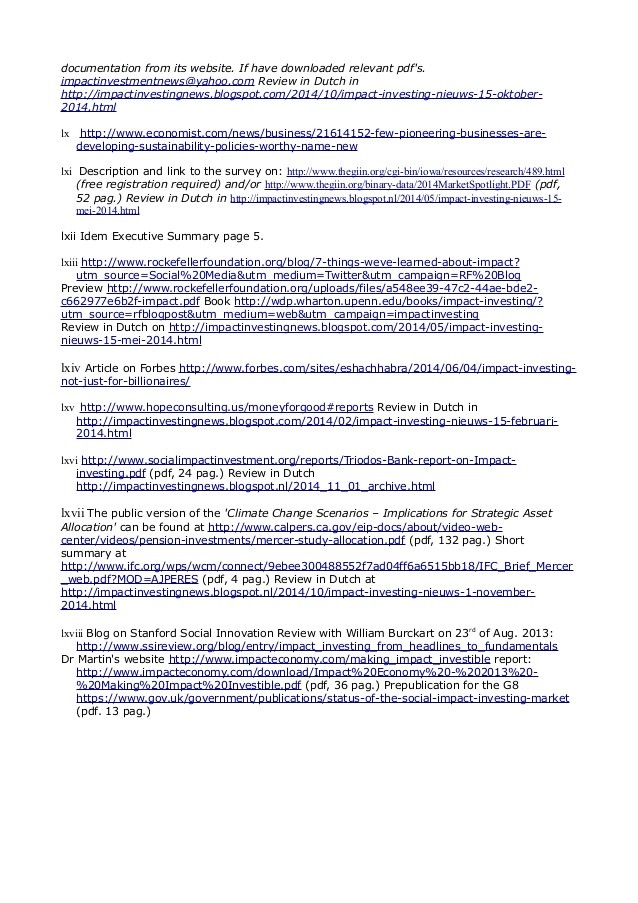Impact Investing Will It Make a Difference US News
Post on: 1 Июнь, 2015 No Comment

The great promise of Impact Investing is in creating a better capital market for the social sector.
John Vogel is an adjunct professor at Dartmouth’s Tuck School of Business. Megan Shackleton is a Tuck student of the class of 2012.
About a year ago, the New Hampshire Charitable Trust asked us if some Tuck students would be interested in helping them investigate best practices in the new and emerging field of Impact Investing. Our first question was: what do you mean by Impact Investing? The Trust defined it as making investments that would generate a market rate of return in the 8 percent range and also further their mission of improving the quality of life for people living in New Hampshire.
Like most emerging investment categories, there is a wide range of definitions about what constitutes Impact Investing and which investments qualify. For us, the table below showing a spectrum of investment options is a good starting point in defining Impact Investing:
PhilanthropyImpact InvestingSocially Responsible InvestingStandard Investing (Without social or environmental screens)As this table shows, Impact Investing fits somewhere between Philanthropy and Socially Responsible Investing. With Philanthropy, there is no financial return to the investor, but there are societal benefits, or what we call “social impacts“. In contrast, for the category labeled Socially Responsible Investing, the main benefit is the financial return, but investors get satisfaction from making sure the return is not coming from companies with certain negative externalities, like those that produce cigarettes.
Impact Investing fits in the middle. An impact investor tries to have a positive social impact and not simply screen out undesirable companies. At the same time, impact investors are seeking a reasonable financial return. A good example of an impact investment fund is the one that was created in 2011 by Deutsche Bank along with the European Investment Bank called the European Energy Efficiency Fund. The EEEF aims to provide market-based financing for commercially viable public energy efficiency and renewable energy projects within the European Union.
In the United States, the first investors who showed a strong interest in Impact Investing were foundations. Rather than rely simply on their grants, some of the larger foundations, like the Bill and Melinda Gates Foundation, are making Impact Investments and thus using their endowments to further their mission. The $260 million F. B. Heron Foundation in New York currently invests over 35 percent of its endowment in Impact Investments like its loan to the Self-Help Venture Fund, which finances small businesses and community facilities in low wealth communities in North Carolina.
To serve foundations and wealthy individuals, major financial institutions have set up groups specifically focused on this area. Credit Suisse, J.P. Morgan Chase and UBS all promote Impact Investing products and services. These financial institutions claim to have both altruistic and economic reasons for their involvement—responding to opportunities to both drive positive social and environmental change and to cater to a growing client base of investors.
The biggest challenge that all the players in this space currently face is how to measure impact. It is reasonably easy to measure financial returns, but how does one measure social impact? Quantifying and measuring impact, especially across a range of social and environmental organizations, has long been a challenge for nonprofit organizations and social entrepreneurs.
There are two complimentary efforts to create systems that will help investors measure the social impact of their investment the Impact Reporting and Investment Standards launched by the Global Impact Investment Network and the Global Impact Investing Rating Standard created by B Labs. The former strives to set forward clear and consistent language and terminology around social and environmental outcomes. The latter utilizes this language to create reporting standards around social and environmental performance, comparable to Morningstar for traditional investors. For example, by investing in a company that makes solar panels, investors would get annual information like the tons of greenhouse gases that were offset or mitigated. In addition the investor would receive benchmarking data and information about the company’s environmental impact.
According to a report by the Monitor Group, in 2009, $50 billion was invested in Impact Investments. The Monitor Group believes that this category could grow to $500 billion over the next ten years. We suspect that the rate of growth will be related to how high or low the bar is set on what constitutes an Impact Investment and an Impact Investment fund.
To us, success will not be measured by the number of dollars invested or by adding up all the financial and social returns. The great promise of Impact Investing is in creating a better capital market for the social sector. Today, capital does not flow into the social sector in a way that necessarily rewards efficiency and performance.
We also believe that Impact Investing will help social entrepreneurs scale their enterprises. Not only will this be a new stream of capital, but it will be patient capital that aligns with the goals and missions of the social entrepreneurs.














